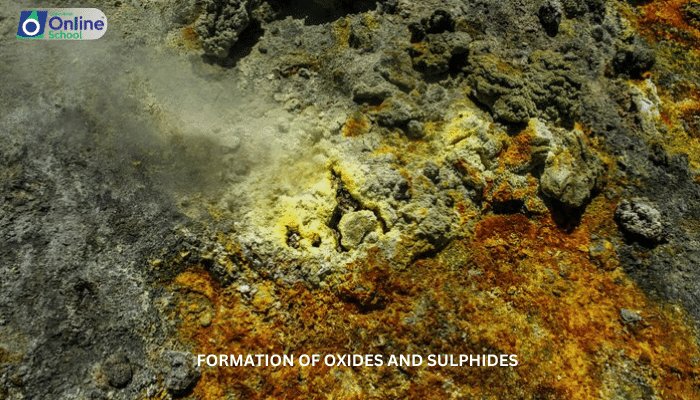
Learning Outcomes:
i. Describe the general principles of oxide and sulfide formation.
ii. Write representative equations for the formation of oxides and sulphides.
iii. Identify the factors influencing the reactivity of metals and nonmetals with oxygen and sulfur.
iv. Apply the concept of oxidation states to predict the products of reactions involving oxide and sulfide formation.
Introduction
Oxides and sulphides are two important classes of inorganic compounds formed by the reaction of metals or nonmetals with oxygen or sulfur, respectively. These compounds play a crucial role in various fields, including metallurgy, construction, and chemical manufacturing. In this lesson, we will explore the formation of oxides and sulphides, examining the general principles and writing representative equations for these reactions.
i. Formation of Oxides
Oxides are formed when a metal or nonmetal reacts with oxygen. The general equation for the formation of an oxide can be represented as:
Element + Oxygen → Oxide
The reactivity of metals with oxygen varies depending on their position in the periodic table. Alkali metals and alkaline earth metals, located in the leftmost groups of the periodic table, are highly reactive with oxygen, forming oxides directly upon exposure to air. For instance, sodium reacts vigorously with oxygen to form sodium oxide:
2Na(s) + O2(g) → 2Na2O(s)
Transition metals generally exhibit moderate reactivity with oxygen, requiring higher temperatures or specific conditions to form oxides. Iron, for example, reacts with oxygen to form iron oxide (FeO) at elevated temperatures:
3Fe(s) + 2O2(g) → Fe3O4(s)
Nonmetals also exhibit varying degrees of reactivity with oxygen. Sulfur reacts readily with oxygen to form sulfur dioxide (SO2), a common air pollutant:
S(s) + O2(g) → SO2(g)
Carbon reacts with oxygen under specific conditions to form carbon dioxide (CO2), a greenhouse gas:
C(s) + O2(g) → CO2(g)
ii. Formation of Sulphides
Sulphides are formed when a metal or nonmetal reacts with sulfur. The general equation for the formation of a sulfide can be represented as:
Element + Sulfur → Sulfide
The reactivity of metals with sulfur generally follows a similar trend to their reactivity with oxygen. Alkali and alkaline earth metals react directly with sulfur to form sulfides. Magnesium, for example, reacts with sulfur to form magnesium sulfide (MgS):
Mg(s) + S(s) → MgS(s)
Transition metals also exhibit moderate reactivity with sulfur, often requiring specific conditions to form sulfides. Iron reacts with sulfur at higher temperatures to form iron sulfide (FeS):
Fe(s) + S(s) → FeS(s)
Nonmetals exhibit varying reactivity with sulfur. Carbon reacts with sulfur to form carbon disulfide (CS2), a solvent used in various industrial applications:
C(s) + 2S(s) → CS2(l)
iii. Factors Influencing Reactivity
The reactivity of metals and nonmetals with oxygen and sulfur is influenced by several factors, including:
Metallic character: Metals with higher metallic character, meaning they readily lose electrons, tend to react more easily with oxygen and sulfur.
Ionization energy: Lower ionization energy, the energy required to remove an electron, facilitates electron loss, making the metal more reactive with oxygen or sulfur.
Electronegativity: The difference in electronegativity between the metal or nonmetal and oxygen or sulfur affects the bond strength and reactivity.
Reaction conditions: Temperature, pressure, and the presence of catalysts can play a significant role in the formation of oxides and sulphides.
iv. Application of Oxidation States
The concept of oxidation states can be applied to predict the products of reactions involving oxide and sulfide formation. The oxidation state of an element represents its hypothetical charge when it forms a compound with other elements. In oxides, oxygen typically has an oxidation state of -2, while in sulfides, sulfur has an oxidation state of -2.
By balancing oxidation states, we can determine the oxidation states of other elements in the compound and predict the products of reactions. For instance, the oxidation state of iron in iron oxide (FeO) is +2, while the oxidation state of magnesium in magnesium sulfide (MgS) is +2.
The formation of oxides and sulphides is a fundamental aspect of inorganic chemistry. Understanding the general principles behind their formation, the factors influencing reactivity, and the application of oxidation states allows us to predict the products of reactions and gain a deeper understanding of the properties.